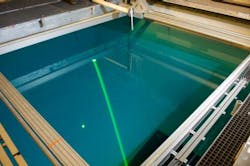Small real-time lidars could allow UAVs to conduct underwater scans
A team at the Georgia Tech Research Institute (GTRI; Atlanta, GA) has designed a new approach that could lead to bathymetric lidars (which scan beneath the water's surface) that are much smaller and more efficient than the current full-size systems. The new technology, developed under the Active Electro-Optical Intelligence, Surveillance and Reconnaissance (AEO-ISR) project, would let modest-sized unmanned aerial vehicles (UAVs) carry bathymetric lidars, lowering costs substantially.
Bathymetric lidars are used today primarily to map coastal waters. At nearly 600 pounds, the existing systems are large and heavy, and they require costly, piloted aircraft to carry them.
Also unlike currently available systems, AEO-ISR technology is designed to gather and transmit data in real time, allowing it to produce high-resolution 3D undersea imagery with greater speed, accuracy, and usability for a range of military uses, such as anti-mine and antisubmarine intelligence and nautical charting, as well as civilian mapping tasks and probing forested areas to detect objects under thick canopies.
The ultimate product of a bathymetric lidar is a 3D point cloud that describes the sea floor at high spatial resolution. Users of these data need to know the accuracy of each point. GTRI’s researchers have devised a new approach for accuracy assessment called total propagated uncertainty (TPU); using statistics, calculus, and linear algebra, the TPU technique propagates errors from the individual measurements (navigation, distance, and refraction angle) to estimate the accuracy of sea-floor measurements.
Real-time coordinate computation
In a major milestone, the GTRI team was the first to demonstrate bathymetric lidar coordinate computation and TPU estimates in real time. To achieve the necessary processing speed, the team uses a mixed-mode computing environment composed of field-programmable gate arrays (FPGAs), along with central-processing and graphics-processing units (CPUs and GPUs).
To simulate the movement of an actual aircraft, the prototype is "flown" over a laboratory pool. To do this, the researchers install the lidar onto a gantry above a large water tank and then operate it in a manner that simulates flight.
The lidar uses a high-power green laser that can penetrate water to considerable depths. Firing a laser beam every 100 microseconds, the proxy aircraft allows the team to study the best methods for producing accurate images of objects on the floor of the pool.
The ultimate goal is to obtain accurate reflectance from the sea floor, but the presence of water makes that difficult. To capture good images, the GTRI lightweight lidar must make a series of adjustments that let it measure reflected laser beams as if there were no water present.
Contending with refraction
One challenge is that when a tightly focused light beam such as a laser hits water, it refracts. Due to changes in the water's surface, the angle of refraction varies constantly, and these changes in the refracted angle must be accounted for when computing the path of the light.
Another challenge is that the photons are scattered in the water, with the amount of scattering depending on the water’s turbidity. In addition, the water absorbs some of the light.
The signal-conditioning and sensor-processing capabilities of the lightweight lidar must be sophisticated enough to detect the small returning signal in an overall sea and air environment that is very noisy.
The immediate goal is to field such mid-size bathymetric device on a larger UAV such as an autonomous helicopter. The longer-term aim is to use AEO-ISR technology to develop bathymetric lidars that could fly on small unmanned aerial vehicles (UAVs) with payloads of 30 pounds or less. To help these lidars deliver maritime surveillance and mapping data in real time, most of the necessary signal processing would be done on the aircraft and only essential data would be transmitted to ground stations.
(Source: GTRI)
About the Author
John Wallace
Senior Technical Editor (1998-2022)
John Wallace was with Laser Focus World for nearly 25 years, retiring in late June 2022. He obtained a bachelor's degree in mechanical engineering and physics at Rutgers University and a master's in optical engineering at the University of Rochester. Before becoming an editor, John worked as an engineer at RCA, Exxon, Eastman Kodak, and GCA Corporation.

